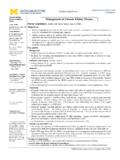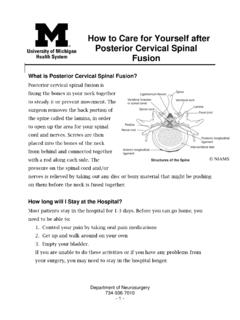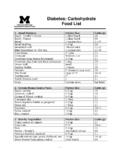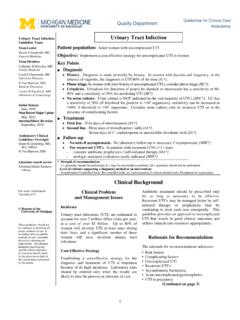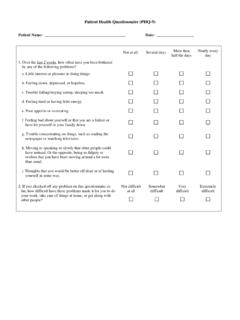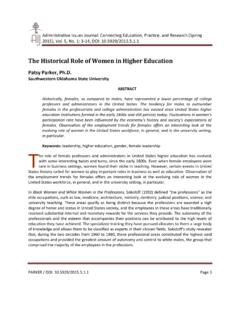Transcription of THE ROLE OF FIBER - Michigan Medicine
1 THE ROLE OF FIBER . Healthy Eating Tip of the Month August 2016. FIBER : the Basics FIBER is a class of nondigestible carbohydrates and lignin which is associated with numerous health benefits. Dietary fibers are those which are native to plants while functional fibers are those which are added to foods. Both dietary and functional fibers can have positive effects on health. Sources of dietary FIBER include grains, fruits, vegetables, and legumes such as beans and peas. An important role of many types of FIBER is their ability to act Soluble & Insoluble as prebiotics substances that alters the types and activities of the bacteria, or microflora, that live inside the human gut.
2 FIBER can be classified While the human microflora remains an active area of several different ways, but scientific research, its relationship with inflammation, immune commonly fibers are function, and the health of the colon are promising areas for categorized as being understanding how FIBER may offer protective effects against a soluble or insoluble. Fruits, variety of diseases. legumes, and oats are rich sources of soluble fibers. Soluble fibers are recognized for their ability to lower LDL ( bad ). cholesterol and may help control blood sugar. Insoluble fibers, like those found in wheat, bran, vegetables, and fruits have been linked to health benefits such as appetite control, reduced incidence of developing type 2.
3 Diabetes, and the Legumes are a great source of FIBER ! prevention of constipation. About FIBER Because of the variety of other vitamins, minerals, and active compounds found in FIBER -rich foods, getting FIBER from a wide Live longer and stronger with FIBER variety of fruits, grains, legumes, and vegetables is usually the best way to consume adequate Why Eat FIBER ? amounts of FIBER . Talk to Several health benefits have been attributed to FIBER your doctor or registered consumption, including: dietitian before starting any type of lower cholesterol and decreased risk of developing supplementation.
4 Cardiovascular disease decreased mortality risk from circulatory, digestive, and inflammatory diseases reduced risk of developing some forms of cancer improved insulin sensitivity and glycemic control weight and appetite control prevention and relief from constipation decreased inflammation Variety matters! increased calcium absorption and bone mineral density Foods which are naturally high in FIBER also contain many other nutrients that are beneficial to health. Vitamins, minerals, trace elements, polyphenols, alkylresorcinols, and carotenoids found in FIBER -rich foods such as wholegrain wheat and rye have been shown to decrease risk for developing type 2 diabetes, cardiovascular disease, and overweight.
5 GET MORE FIBER IN YOUR DIET. Meeting Your FIBER Needs According to the USDA, typical daily intakes of dietary FIBER in Reading Food Labels the United States are less than 18 grams for men and 14. Look for foods containing the word grams for women only about half of the recommended whole in the first ingredient amount. So, how can you increase your intake? Eat a variety of high FIBER foods every day, and use food labels to select foods that are higher in FIBER . Whole grains, vegetables, fruits, and legumes are the best sources of FIBER . Choose foods with at least 3g of FIBER per serving Look for the Daily FIBER Needs by Age and Gender WHOLE GRAIN.
6 Stamp on grain The amount of FIBER you need depends on your age and products like breads and cereals gender. Follow the USDA recommendations below for adequate FIBER intake: Quick tips! Adults Children Make half your grains whole Men 1 3 years grains 19-50 years 38 grams (boys and girls) 19 grams Eat more whole fruits and 50+ years 30 grams 4-8 years vegetables, including the skin Women (boys and girls) 25 grams Avoid stomach upset and 19-50 years 25 grams 9-13 years constipation while 50+ years 21 grams Boys 31 grams increasing your FIBER intake Pregnant Women Girls 26 grams by: 14-50 years 28 grams 14-18 years - increasing FIBER intake gradually, and Lactating Women Boys 38 grams - drinking plenty of fluids 14-50 years 29 grams Girls 26 grams Good Sources of FIBER Getting more FIBER in your diet is easy.
7 By having just a few extra servings of the delicious FIBER -packed foods below, you'll be on your way to a healthier you! What is a Whole Whole Grains for Health Grain? Data from the USDA indicates that Americans who eat more A whole grain is an whole grains are more likely to meet their FIBER needs. In unrefined grain that addition to FIBER , whole grains are filled with antioxidants, contains three layers: vitamins, and minerals that are essential to good health. the bran, germ, and endosperm. The bran Adding even one serving of whole grains to your diet helps is rich in FIBER and B with weight control and can reduce your risk for developing vitamins.
8 The germ is several chronic diseases: loaded with antioxidants. The Stroke endosperm is mostly starch. Diabetes Unlike whole Heart disease grains, refined Inflammatory diseases grains have had Some cancers the bran and High blood pressure germ layers removed, leaving mostly just the starchy endosperm. Whole Grains Hulled Barley Brown Rice Colored Rice Buckwheat Whole corn Oats Whole Rye Whole Wheat Wild Rice Amaranth Millet Sorghum Teff Triticale Quinoa Make half of your grains whole grains, and have at least 3 servings a day! Every Plate, All Day Gluten Free Cooking with whole grains is simple and usually takes only 10.
9 Doesn't Mean -15 minutes. Cooking whole grains into soups, entr es, and Whole Grain snacks is both wholesome and delicious. Try preparing: Free Most people can eat Hearty Chicken Rice Soup a variety of whole grains, but some Quinoa Stuffed Peppers people are allergic to gluten a protein Coconut Almond Granola Bars found in wheat, rye, and barley. The Baked Blueberry & Peach Oatmeal benefits of a diet rich in whole grains Visit for more tasty recipes and can still be enjoyed details on the latest research on whole grains. even with a gluten allergy by including grains that don't Whole Grains at Every Meal contain gluten: Breakfast Corn Rice Start the day right with whole grain breads, cereals, waffles, pancakes, or a Oats*.
10 Bowl of hot oatmeal. Wild rice Lunch Amaranth Make sandwiches with whole grain breads Buckwheat and add brown rice or bulgur wheat to Quinoa soups and salads. Millet Dinner Sorghum Wild rice or quinoa make great side Teff dishes for your favorite meals and will give you the added benefits of FIBER and antioxidants. *Oats do not contain gluten Snacks & Sweets naturally but may be contaminated Popcorn and whole grain granola during processing. Look for certified bars and crackers will combat your gluten-free oats. midday hunger pangs or sweet tooth and help keep you satisfied. Content retrieved and modified from the Whole Grain Council MORE FIBER FOR YOUR CHILDREN.

